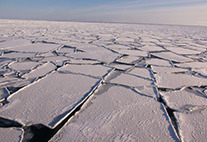20 April 2016
Higher waves further jeopardize the Arctic

Photo: UHH/CEN/Dobrynin
By the end of this century, the Arctic could experience up to seven ice-free months per annum if greenhouse gas emissions are not reduced. Increasingly ice-free waters will trigger novel and higher waves. Oceanographer Mikhail Dobrynin from Universität Hamburg’s Center for Earth System Research and Sustainability (CEN) made this prediction today during the General Assembly of the European Geosciences Union (EGU) in Vienna, Austria. More powerful waves will break up the sea ice faster and affect pristine seabed and coastal areas.
The Arctic sea ice edge forms a natural barrier that slows down waves. The lower the total sea ice extent gets, the more space is available for growing wave activity. As the Arctic sea ice cover is dwindling in the course of global warming, winds take up speed. According to Mikhail Dobrynin’s research results, this produces waves in larger numbers and sizes. If such waves hit an ice edge, they will crack it up further and make the ice melt faster (see figure 1).
Assuming uncurbed greenhouse gas emissions—in line with the so-called scenario RCP 8.5 of the Intergovernmental Panel on Climate Change (IPCC)—the Arctic will remain ice-free for approximately seven months in the year 2100. In past decades, the summer Arctic sea ice still covered six million square kilometres, on average. The open waters of the future will create a whole new wave system. In addition, North Atlantic waves will expand unhindered into the Arctic Ocean (see figure 2). “The Northeast Passage would allow regular transit of ships in the summer. But where there is ice today, cargo ships would have to battle tall waves,” says Dobrynin.
Wave dynamics do not only influence the ice itself but also extend to a water depth of about 200 meters. Thus, the currently unspoilt seabed underneath the ice would be churned up with unknown ramifications for the local ecosystem (see figure 3). This development also affects the coastlines. Dobrynin shows that waves, for instance in the Laptev Sea, stir up more and more sediments. At the same time, they may erode adjoining permafrost land regions (see figure 4). “On top of global warming, this could accelerate the ice melt with the risk of releasing additional greenhouse gas emissions from permafrost,” explains Mikhail Dobrynin.
The researcher employs computational climate models to establish current and future wind and ice values for his prognoses. His results enable him to calculate various wave characteristics such as wave height, length, and friction velocity. The latter indicates the current-induced stress condition in the seabed. Subsequently, Dobrynin compares data for the periods from 2000 to 2010 and 2090 to 2100—all based on the assumption that greenhouse gas emissions will stay the same. In that case, the global temperature would rise by an average of four degrees Celsius until 2100. Similar but less severe effects will occur in the event of reduced emissions and a moderate temperature rise of two to three degrees.
